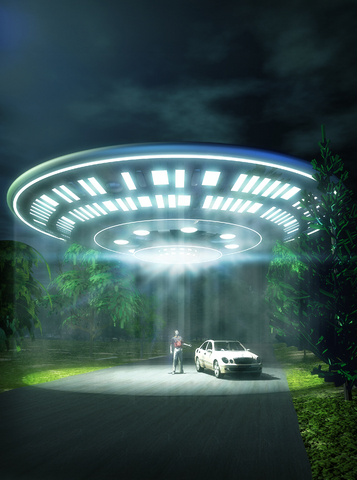The Singularity and UFOs: Can ET Teach Us Anything about the Singularity?
The connections between extraterrestrial life and future technology are numerous, and have been widely discussed in science fiction literature and by physicists such as Michio Kaku. There is basic logic to the connection: if life in other galaxies is able to travel to our galaxy, it is thought, then we should assume their technology is more advanced than our own and that they have already reached their ‘Singularity.’
 Recently I attended the 20th Anniversary International UFO Congress in Scottsdale, AZ, which included 5 full days of presentations, special events, and films, attracting over 700 attendants. Various theorists, physicists, former military personnel, many of whom claim to have witnessed extraterrestrial life, presented ideas and stories on a wide range of topics.
Recently I attended the 20th Anniversary International UFO Congress in Scottsdale, AZ, which included 5 full days of presentations, special events, and films, attracting over 700 attendants. Various theorists, physicists, former military personnel, many of whom claim to have witnessed extraterrestrial life, presented ideas and stories on a wide range of topics.
I was surprised by the lack of discussion of the technological singularity at the conference. However many of the presentations provided useful insights into what a Singularity in other galaxies would entail, if the reports presented were valid.
One consistent observation coming from those claiming to have experienced UFOs was how quiet, and many say, silent, UFO spacecrafts are. At this event, the most well-respected, and in my opinion, most believable, alien abductee, Travis Walton (best known by the film based on his story Fire in the Sky), remarked on the experience of watching the spacecraft exit his vision (back in 1975), surprised that it was an experience with no sound, especially given how fast it appeared to be traveling.
Many people notice how quiet hybrid cars are compared to combustion engines. Transportation in civilizations with advanced technology appears to be almost completely silent.
Other consistent claims were the high level of design sophistication of spacecrafts, which were consistently portrayed being able to travel at very rapid speeds and maneuver with great agility.
Lloyd Pye, the man primarily associated with the infamous Starchild Skull presented recent genetic information indicating what he thinks shows that the Starchild skull is not of human origin. He bases this claim upon (reportedly) finding that the DNA of the Starchild has vastly different mitochondrial DNA(mtDNA) from human mtDNA. Since mtDNA in humans mutates very little, he argues, the likelihood of the Starchild being a mutation he thinks is very low.
[youtube]https://youtu.be/moEYqLdupIA[/youtube]
He suggests genetic engineering from an advanced civilization as possible explanation for the Starchild Skull. He wouldn’t name the geneticists working with him and is looking for funding of $7 million to finish the DNA sequencing and make two documentaries.
Needless to say, there were presentations at the conference that were quite obviously for the purpose of taking advantage of older, and less critical thinkers. These con artist presenters, some using very obviously Photoshopped images, combined messages of vague, new-age spirituality and abduction claims for the purpose, arguably, of media publicity, and making money through book revenues.
I myself, the band hired to entertain at the conference, and a handful of others were the only attendees under the age of 30, with the average age being around 60. The popularity of aliens was, after all, at its height between 1940-1980. The lack of technical and up to date scientific knowledge on the part of the older attendees definitely allowed con artists to get further and sway more minds than they would have in a younger crowd.
There seemed to be resentment, or at least an attempt to create resentment on the part of the crowd, by the speakers towards the scientific community. Those working in more mainstream science fields tend to reject the claims of alien encounters on rational or scientific grounds, and for that were referred to in a derogatory way by many speakers, referred to as simply ‘the scientists.’
One highlight of the conference was most certainly the presentations of James Penniston and John Burroughs regarding the Bentwaters Mystery, also known as the Rendlesham Forest Incident. It is one of the more well-known and respected UFO reports to date and many people find the case convincing.
Unfortunately, if one had knowledge of the Singularity, one was easily skeptical of the central message. They claim that their experience with aliens in 1980 was actually an experience with humans (having perfected knowledge of physics) visiting us from 40,000 years in the future. The purpose they claim for the visit was to obtain human DNA for the sake of knowledge and other things.
Penniston spoke about the time travel message during hypnosis in 1994. So, these ideas were put forth prior to our mapping and banking the human genome. Had they foreseen our doing this they may have claimed something different perhaps. In their defense, since this information was produced through hypnosis, they may not be entirely to blame for the fiction of these claims.
Off the record, Penniston was questioned by a conference attendee regarding this discontinuity. He claimed, rather defensively, that he didn’t know how to explain the need for human DNA by these future beings since we have so much of it stored now. “I don’t know, I don’t know” Penniston remarked nervously, trying to escape the questioners.
Having knowledge of future technology trends, and being able to understand what future technology would be required for another species able to travel all the way to our galaxy (nanotechnology, advanced computational abilities), allows one to be an effective skeptic, and makes one less susceptible to UFO con artists. One could also make up better stories about the intent of aliens as well.
But there are important things that Singularitarians can learn from discourse about aliens, even the fiction.
One interesting thing to ponder is the variety seen in the description of alien encounters cross culturally. As discussed in the “Cross Cultural Patterns in Abductions” sections of the MIT Discussions, there is very little coherence in descriptions of the experiences.
Cultural perceptions of advanced technology play a role in how alleged alien encounters play out, so we can look at the descriptions of these encounters for insight into how we as a culture perceive advanced technology.
It is well known that Japanese culture has a warmer regard for robots and futuristic technology, compared with the Western culture, which is typically more fearful of it.
Skeptics argue that science fiction since the 1930s has influenced and shaped expectations of alien encounters in the West.
A 1935 issue of Amazing Stories, which featured on its cover “an illustration of a being with large eyes and a large head who was restraining a human from entering a room where another human was reclined on a table with another large-eyed creature examining her,” for instance, is thought to have influenced and shaped expectations of what an encounter with extraterrestrials might entail.
It is a common experience for those enthusiastic about advanced technology to have their views met with pessimism by those steeped in science fiction literature and films.
Most Americans believe there is intelligent life elsewhere in the universe. Many futurists agree that there is as well. Where futurists disagree is on whether or not another species has visited earth. Ray Kurzweil, for instance, in Time’s 10 Questions for Ray, argues that there is no evidence of intelligent life elsewhere that we have so far witnessed. For this reason he thinks we are likely to be the first species to reach a Singularity.
 Many disagree with Ray on this. I for one find it difficult to dismiss the abduction case of Travis Walton, especially given the consistency in witness testimony, and especially after having met him and listened to him speak on the matter. Not to mention, the prevalence of alleged alien phenomenon, and famous UFO cases witnessed by thousands such as the Phoenix Lights lead us to believe that something regarding aliens and advanced technology is in need of explanation.
Many disagree with Ray on this. I for one find it difficult to dismiss the abduction case of Travis Walton, especially given the consistency in witness testimony, and especially after having met him and listened to him speak on the matter. Not to mention, the prevalence of alleged alien phenomenon, and famous UFO cases witnessed by thousands such as the Phoenix Lights lead us to believe that something regarding aliens and advanced technology is in need of explanation.
The issue of extraterrestrial life raises interesting questions for those interested in the Singularity.
Should some of the stories be true, what does that tell us about our own future? Will we very soon be doing what aliens are now doing, travelling to other galaxies to investigate more primitive civilizations? And if alien encounters are indeed as negative as some abductees claim, will there be an intergalactic battle for mankind’s survival post Singularity as portrayed in science fiction?
About the Author:
N ikki Olson is a writer/researcher working on an upcoming book about the Singularity with Dr. Kim Solez, as well as relevant educational material for the Lifeboat Foundation. She has a background in philosophy and sociology, and has been involved extensively in Singularity research for 3 years. You can reach Nikki via email at [email protected].
ikki Olson is a writer/researcher working on an upcoming book about the Singularity with Dr. Kim Solez, as well as relevant educational material for the Lifeboat Foundation. She has a background in philosophy and sociology, and has been involved extensively in Singularity research for 3 years. You can reach Nikki via email at [email protected].
Related articles









